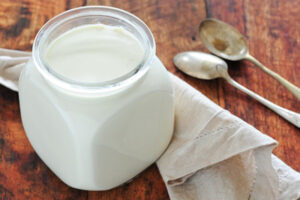YOGHURT

Gut health is very topical, both in nutrition research and marketing. We are understanding just how important it is to keep our gut and its tiny microbes healthy and happy for both physical and mental health. Fermented dairy foods such as yoghurt can help, and they are delicious to boot.
The story of how yogurt was discovered goes a little like this. In ancient times, milk was being carried in a leather pouch and with warmth and time the natural bacteria present in the milk feasted on the natural sugar (lactose) in the milk and created lactic acid as a by-product. And voila; yoghurt was created with its characteristic tart flavour and thicker texture. While this tale is hard to prove, it’s totally plausible and a great story! It incorporates the basics of what yoghurt is, and how it is created. It’s the bacteria in yogurt that are thought to help support a healthy gut. The term ‘probiotic’ is used to describe bacterial cultures in foods like yoghurt that have beneficial effects on the community of billions of microorganisms (bacteria, yeast, viruses) in the gut, called the ‘microbiota’. Another related term is the ’microbiome’ that describes the combined genetic material of these microorganisms. And this theory has been demonstrated in research: eating yoghurt regularly is associated with beneficial changes in our gut microbiome.
Yoghurt has all the essential nutrients found in the original milk, probiotic benefits, and a low glycemic index (GI). Yoghurt is a great source of calcium for healthy bones and contains significant amounts of vitamins A, B12 and riboflavin, as well as minerals including phosphorous, potassium, magnesium and zinc. Yoghurt contains lower levels of lactose than milk due to the action of the bacterial cultures and is better tolerated by people who don’t digest lactose well. Dairy also contains unique bioactive proteins and peptides (small protein fractions) that have shown a range of health benefits including enhancing satiety (feeling full). Consumption of milk and dairy foods is associated with beneficial or neutral effects on blood pressure, cardiovascular disease and type 2 diabetes.
Yoghurt is a versatile ingredient and delicious in savoury or sweet dishes. Natural yoghurt is an excellent base for dips like Middle Eastern baba ghanoush or Indian raita and sauces, and an excellent dollop on top of soups and curries. It pairs beautifully with fruit, nuts and honey, and is great in smoothies and baking. Straining natural yoghurt creates a thicker product, as in Greek yoghurt and Middle Eastern labneh – be sure to keep the straining liquid and use it in cooking or baking.
Commercially produced yoghurt is a convenient nutrient-dense snack or meal accompaniment. And because yoghurt is fermented, it has a longer shelf-life and that’s helpful in our quest to avoid food waste. Try to buy it in larger containers to reduce packaging. You could make your own yoghurt to save money and eliminate packaging. It’s not difficult, especially using a commercial yoghurt maker that keeps the milk and culture warm to let the bacteria do their thing. You can use a commercial yoghurt mix (powdered milk and culture) or a big dollop of quality natural yoghurt as a starter in milk.
Yoghurt has a long history of enjoyment around the world and an important place in many cuisines. It’s an ancient food we would do well to hang on to in the modern world.
| Yoghurt (natural, full cream, Greek style) |
|
| 4.5 Health Stars | |
| Glycemic index | 12 |
| Serving size – 200 mL (7 oz) | |
| Kilojoules | 915 |
| Calories | 220 |
| Protein (g) | 10.0 |
| Fats (g) – total | 7.0 |
| Includes: – Saturated fat (g) | 4.5 |
| – Monounsaturated fat (g) | 2.2 |
| – Polyunsaturated fat (g) | 0.2 |
| Saturated : unsaturated fat ratio | 0.5 |
| Carbohydrates (g) – Total | 27.6 |
| Available (Includes): | 27.6 |
| –Natural sugars (g) | 27.6 |
| –Natural starches (g) | 0 |
| –Added sugars (g) | 0 |
| –Added starches (g) | 0 |
| Unavailable (Includes): | 0 |
| –Dietary fibre (g) | 0 |
| Sodium (mg) | 125 |
| Potassium (mg) | 457 |
| Calcium (mg) | 344 |
| Glycemic load (g) | 3.3 |
| Diabetes exchanges | 2 |
| Ingredients: Pasteurised whole milk, cream and live probiotic cultures |
- Le Roy and colleagues. Yoghurt consumption is associated with changes in the composition of the human gut microbiome and metabolome. BMC Microbiol. 2022.
- Auestad and Layman. Dairy bioactive proteins and peptides: a narrative review, Nutrition Reviews, 2021.








